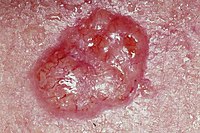
Photo from wikipedia
Background Sézary Syndrome (SS) is an aggressive leukemic variant of cutaneous T-cell lymphomas (CTCL). In SS patients, malignant T cells are circulating through the blood and cause erythroderma. Objective To… Click to show full abstract
Background Sézary Syndrome (SS) is an aggressive leukemic variant of cutaneous T-cell lymphomas (CTCL). In SS patients, malignant T cells are circulating through the blood and cause erythroderma. Objective To compare the transcriptome of single cells in blood and skin samples from a patient with advanced SS. Methods We utilized combined single cell RNA and T-cell receptor (TCR) sequencing (scRNA-seq). Results We scrutinized the malignant T cells in blood and skin in an unbiased manner without pre-sorting of cells. We observed different phenotypes of the same monoclonal malignant T-cell population, confirmed by TCR sequencing and inferred copy number variation analysis. Malignant T cells present in the circulating blood expressed genes resembling central memory T cells such as CCR7, IL7R and CD27. In the skin, we detected two major malignant T-cell populations: One subpopulation was closely related to the malignant T cells from the blood, while the other subpopulation expressed genes reminiscent of skin resident effector memory T cells including GZMB and NKG7. Pseudotime analysis indicated crucial transcriptomic changes in the transition of malignant T cells between blood and skin. These changes included the differential regulation of TXNIP, a putative tumor suppressor in CTCL, and the adaptation to the hypoxic conditions in the skin. Tumor cell proliferation in the skin was supported by stimulating interactions between myeloid cells and malignant T cells. Conclusions Using scRNA-seq we detected a high degree of functional heterogeneity within the malignant T-cell population in SS and highlighted crucial differences between SS cells in blood and skin.
Journal Title: Frontiers in Oncology
Year Published: 2023
Link to full text (if available)
Share on Social Media: Sign Up to like & get
recommendations!